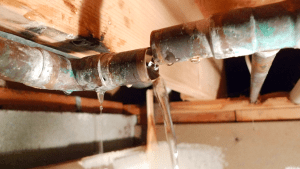Guide To Water Leak Discovery In The House
Guide To Water Leak Discovery In The House
Blog Article
Were you in search of related information on Locating water leaks?

Early detection of leaking water lines can mitigate a possible disaster. Aside from conserving you money, it will decrease the aggravation and also irritation. The moment you discover a leakage, calling your plumber for repair services is the very best solution. Nonetheless, some little water leakages might not show up. Right here are some hacks that help if you can not detect it with your nude eyes.
1. Analyze the Water Meter
Every house has a water meter. Examining it is a guaranteed manner in which assists you discover leakages. For starters, switch off all the water sources. Make certain no one will certainly flush, make use of the faucet, shower, run the cleaning machine or dishwashing machine. From there, most likely to the meter and watch if it will certainly change. Because no person is using it, there ought to be no activities. That shows a fast-moving leakage if it relocates. Likewise, if you discover no changes, wait a hr or 2 and also examine back again. This implies you may have a slow leak that could also be below ground.
2. Examine Water Usage
Assess your water costs and track your water consumption. As the one paying it, you ought to see if there are any inconsistencies. If you identify sudden changes, despite your intake being the same, it means that you have leakages in your plumbing system. Keep in mind, your water expense need to drop under the same variety every month. An unexpected spike in your costs shows a fast-moving leak.
A constant rise every month, even with the exact same routines, reveals you have a slow leak that's additionally slowly escalating. Call a plumber to thoroughly inspect your residential or commercial property, especially if you really feel a warm location on your floor with piping below.
3. Do a Food Coloring Test
30% comes from toilets when it comes to water intake. Test to see if they are running effectively. Drop flecks of food shade in the tank and also wait 10 mins. There's a leak between the storage tank as well as dish if the shade in some way infiltrates your dish throughout that time without flushing.
4. Asses Outside Lines
Don't fail to remember to examine your outdoor water lines as well. Needs to water permeate out of the connection, you have a loose rubber gasket. One small leak can lose tons of water as well as surge your water expense.
5. Assess the scenario and also evaluate
Home owners need to make it a behavior to examine under the sink counters as well as even inside cabinets for any kind of bad odor or mold and mildew growth. These two warnings suggest a leak so punctual interest is required. Doing regular examinations, even bi-annually, can save you from a significant problem.
Extra significantly, if you know your residence is already old, maintain a watchful eye on your heaters, tubes, pipelines etc. Look for stainings and damaging as most pipes and also devices have a life span. They will certainly likewise naturally deteriorate due to wear and tear. Don't wait for it to rise if you presume dripping water lines in your plumbing system. Call an expert plumber as soon as possible so you don't wind up with a terrible mess in your house.
Early detection of dripping water lines can reduce a potential calamity. Some tiny water leaks might not be visible. Examining it is a guaranteed way that helps you uncover leakages. One little leak can waste heaps of water and surge your water costs.
If you believe leaking water lines in your plumbing system, don't wait for it to intensify.
The Dangers of Undetected Water Leaks
Mold
One of the most common results of undetected water leaks in your home is mold. Under the right conditions, mold can begin to grow and spread in just a day or two.
Moisture from water leaks combined with humidity and lack of ventilation allow mold spores to germinate and start spreading.
And while household mold doesn’t carry the same health risks as substances like asbestos, they can cause allergic reactions in people sensitive to them or with asthma.
Structural Damage
When water leaks occur in places we can’t see — above the ceiling, behind walls or beneath floors — they often have time to do some serious damage before making themselves known.
You might notice cracks or bubbles appear in your walls or a slow drip or water from the ceiling.
These are signs of water leaks and buildups in the structure of your home. If you don’t jump on these problems soon enough, the wood frame that supports your house could start rotting, leading to costly repairs and increasing the risk of disasters like ceiling or wall collapses.
Water Waste
According to the Alliance for Water Efficiency, the average home can lose anywhere from 2,000 to 20,000 gallons of water per year due to leaks.
High numbers like that might make you imagine a burst pipe spewing out water. But believe it or not, even a small, constant drip from a kitchen sink could add up to over a thousand gallons of wasted water in a single year.
And if you live in a place where you pay for every gallon of water you use, that adds up to a lot of dollars down the drain. So we understand leaks are bad. Let’s take a look at some of the common (and not-so- common) water leaks you might find around your home.
Flush Valve Flapper
The flush valve flapper is a rubber flap that sits above the flush valve at the bottom of the tank. It’s attached to the flusher with a chain. Over time, it can get worn out and lose its seal, causing an endless flow of water into the toilet bowl.
These leaks are hard to detect since they’re usually silent, but there’s a little insider trick you can use with just a little dye or food coloring:
Put a few drops in the toilet tank. Check the water in your toilet bowl 15 minutes later. If any of the color made it into the toilet bowl, you’ll know what the culprit is.
Fill Valve
The fill valve is what replenishes your toilet’s tank water after you flush. If you’ve ever looked inside your toilet tank and seen water gushing out of an upright plastic valve, that’s a faulty fill valve.
https://meetflo.com/blogs/flo/how-to-find-and-repair-water-leaks-a-comprehensive-guide

I hope you liked our section about Leaking water lines. Thank you so much for finding the time to read through our article. Sharing is caring. Helping others is fun. Bless you for your time. Visit us again soon.
Report this page